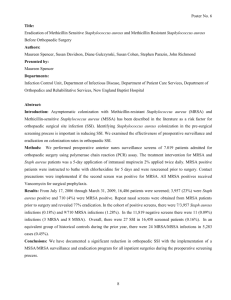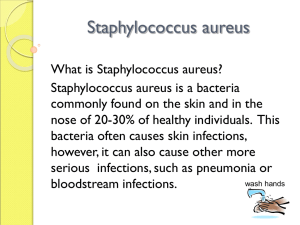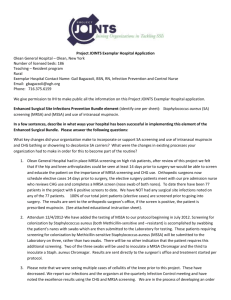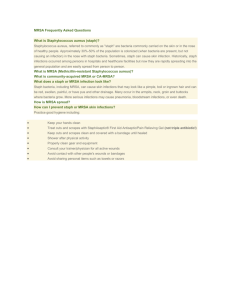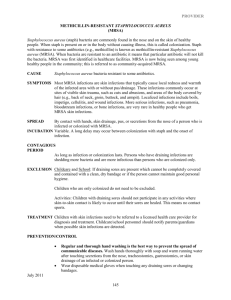Secular trends in the incidence of Staphylococcus aureus bacteremia
advertisement
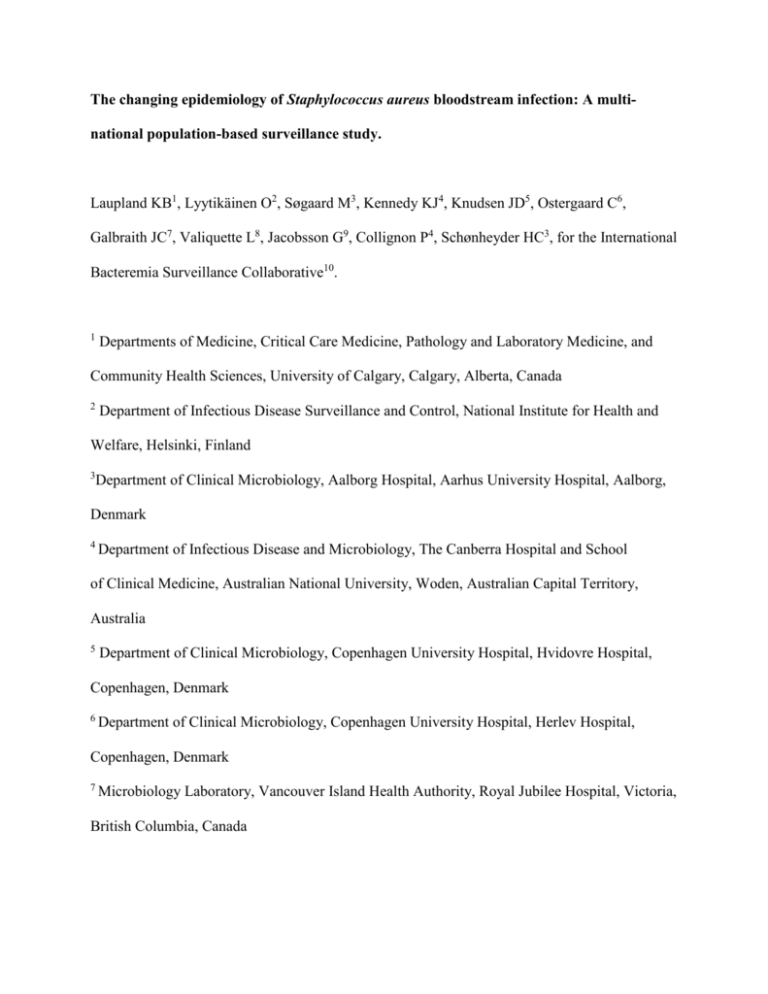
The changing epidemiology of Staphylococcus aureus bloodstream infection: A multinational population-based surveillance study. Laupland KB1, Lyytikäinen O2, Søgaard M3, Kennedy KJ4, Knudsen JD5, Ostergaard C6, Galbraith JC7, Valiquette L8, Jacobsson G9, Collignon P4, Schønheyder HC3, for the International Bacteremia Surveillance Collaborative10. 1 Departments of Medicine, Critical Care Medicine, Pathology and Laboratory Medicine, and Community Health Sciences, University of Calgary, Calgary, Alberta, Canada 2 Department of Infectious Disease Surveillance and Control, National Institute for Health and Welfare, Helsinki, Finland 3 Department of Clinical Microbiology, Aalborg Hospital, Aarhus University Hospital, Aalborg, Denmark 4 Department of Infectious Disease and Microbiology, The Canberra Hospital and School of Clinical Medicine, Australian National University, Woden, Australian Capital Territory, Australia 5 Department of Clinical Microbiology, Copenhagen University Hospital, Hvidovre Hospital, Copenhagen, Denmark 6 Department of Clinical Microbiology, Copenhagen University Hospital, Herlev Hospital, Copenhagen, Denmark 7 Microbiology Laboratory, Vancouver Island Health Authority, Royal Jubilee Hospital, Victoria, British Columbia, Canada 8 Department of Microbiology-Infectious Diseases, Université de Sherbrooke, Sherbrooke, Québec, Canada 9 Department of Infectious Diseases, Skaraborg Hospital, Skövde, Sweden 10 The International Bacteremia Surveillance Collaborative includes Karina J. Kennedy, Peter Collignon (Canberra, Australia), Kevin B. Laupland, Deirdre L. Church, Daniel B Gregson (Calgary, Canada), Louis Valiquette (Sherbrooke, Canada), John Galbraith, Pamela Kibsey (Victoria, Canada), Henrik C. Schønheyder, Mette Søgaard (Aalborg, Denmark), Jenny Dahl Knudsen, Christian Østergaard, Ulrich S. Jensen, Magnus Arpi (Copenhagen, Denmark), Kim O. Gradel (Odense, Denmark), Gunnar Jacobsson (Skövde, Sweden), Outi Lyytikäinen (Helsinki, Finland) Running Title: Staphylococcus aureus bacteremia Address correspondence to (reprints will not be ordered): Kevin B. Laupland, MD, MSc, FRCPC Critical Care Medicine Peter Lougheed Centre 3500-26th Street NE Calgary, Alberta, CANADA T1Y 6J4 Tel: (403) 943-5785 Fax: (403) 291-1491 Email: Kevin.laupland@calgaryhealthregion.ca ABSTRACT Background: The epidemiology of Staphylococcus aureus bloodstream infection (BSI) has been changing in recent years especially with the emergence of methicillin-resistant (MRSA) strains. However, few studies have examined the epidemiology of all S. aureus BSI at the population level and there are no international comparisons. We sought to determine the population incidence of S. aureus BSI and assess trends in incidence over time and by region. Methods: Population-based surveillance for all incident S. aureus BSI was conducted nationally in Finland and regionally in Canberra, Australia, western Sweden, and three areas in each of Canada (Calgary, Victoria, and Sherbrooke) and Denmark (North Denmark Region, Copenhagen County, and Copenhagen City) during 2000-2008. Incidence rates were age- and genderstandardized to the European Union 27-country 2007 population. Findings: During more than 83 million person-years of surveillance, 18,304 episodes of S. aureus BSI were identified of which 17,492 (95·6%) were methicillin-sensitive (MSSA) and 812 (4·4%) were MRSA. The very young, the elderly, and males were at highest risk. The overall age and gender standardized annual incidence rate for S. aureus BSI was 25·6 per 100,000 population, and this was 23·7 and 1·9 per 100,000 for MSSA and MRSA disease, respectively. The overall adjusted annualized incidence rates (per 100,000) for S. aureus BSI were markedly different (p<0.001) among the surveillance regions and were 18·6 for western Sweden, 20·3 for Finland, 21·1 for Victoria, 21·5 for Sherbrooke, 28·6 for Calgary, 26·3 for Canberra, 30·6 for North Denmark, 31·0 for Copenhagen City, and 32·1 for Copenhagen County. While the overall incidence of community onset MSSA disease (14·6 per 100,000) was relatively similar across regions, rates of hospital onset MSSA (9·1 per 100,000), community onset MRSA (1·0 per 100,000), and hospital onset MRSA (0·8 per 100,000) varied substantially by surveillance area. While the overall rate of S. aureus BSI did not increase over the study period, there was an increase in the incidence of MRSA. Major changes in the occurrence of community- and hospital-onset MSSA and MRSA BSI occurred but these varied significantly among regions even within the same country. Interpretation: Although major changes in the epidemiology of community- and hospital onset MSSA and MRSA infections are occurring, this multi-national population-based study did not find that the overall incidence of S. aureus BSI is increasing. Care should be exercised in generalizing results about the epidemiology of S. aureus infections based on previous studies conducted in selected populations or single regions. Funding: No external funding was received in support of this study. BACKGROUND Staphylococcus aureus is the second most common cause of bloodstream infection (BSI) and is the most important cause of BSI-associated death 1-3. Population-based studies conducted in many regions around the world have identified rates of 15-40 per 100,000 population per year with case-fatality rates of approximately 15-25% 4-16. The epidemiology of S. aureus BSI appears to be changing. Many regions worldwide have witnessed increases in the overall incidence of S. aureus BSI, and there has been an increased number and severity of infections due to methicillin-resistant S. aureus (MRSA) associated with the emergence of communityassociated strains in many jurisdictions 11,14,15,17-25. However, it is unclear whether these increases in MRSA infection may be replacing or adding to the burden of disease due to methicillinsensitive S. aureus (MSSA) 6,13,22-24,26-28. In addition, it is not known to what extent changes in occurrence of both MSSA and MRSA bloodstream infections may be due to shifts in incidence between community- and hospital-based patients. In order to best establish the distribution and determinants of an infectious disease, populationbased studies are optimal. This is because in these designs, selection bias is minimized by inclusion of all cases of disease occurring among residents of a defined population. Furthermore, by virtue of the fact that all cases are identified among a known population, shifts between subpopulations such as community and hospital can be evaluated and comparisons among different populations and time periods are facilitated. With the exception of one study that specifically compared MRSA rates between the UK and the USA 29, population-based studies investigating the epidemiology of invasive or bacteremic S. aureus disease to date have been limited to single regions or one country. The objective of this study was therefore to define the occurrence of all MSSA and MRSA BSI within a large multi-national population and to evaluate temporal and regional differences. We were specifically interested to determine whether the overall incidence of S. aureus BSI has been changing and whether MRSA may be replacing or adding to the burden of disease caused by MSSA. METHODS Study protocol This study utilized a multi-center population-based cohort design. Active surveillance was conducted nationally in Finland and in eight other regions within Australia, Canada, Denmark, and Sweden under the auspices of the International Bacteremia Surveillance Collaborative 30. All incident episodes of S. aureus BSI as defined by the growth of this organism from one or more blood cultures from residents of the surveillance populations during January 1, 2000 to December 31, 2008 were identified. Study laboratories were estimated to identify overall ≈99% of all positive blood cultures from residents of the surveillance regions and were equipped with electronic information systems to allow complete retrieval of recorded data. Patient age and gender were recorded and isolates were determined to be MSSA or MRSA using standard methodology according to the protocols established in each of the participating centers. Cases were classified as hospital onset if first culture was obtained more than two days after admission to hospital or within two days of discharge and were considered community onset otherwise. The Conjoint Health Research Ethics Board at the University of Calgary approved this study and each centre complied with their local specific scientific and ethical review requirements. Surveillance populations The Canberra Region (population 370,000) includes the city of Canberra within the Australian Capital Territory and the satellite city of Queanbeyan and several small surrounding rural towns within the state of New South Wales 31. The three Canadian centers included Sherbrooke, Quebec, Victoria, British Columbia, and Calgary, Alberta. Sherbrooke has a population of 152,000 residents and is served by a single microbiology laboratory located in the Centre Hospitalier Universitaire de Sherbrooke 13. Data from the Victoria area included the south local health area of the Vancouver Island Health Authority (population 364,000), and cases were identified at the regional microbiology laboratory 30. Laboratory based surveillance in the Calgary Health Region (population 1.2 million) was conducted at Calgary Laboratory Services 32 . The Danish surveillance regions included the North Denmark Region and two areas within the Capital Region of Denmark. The North Denmark Region surveillance was conducted using the previous boundaries of the North Jutland County (population 495,000). Surveillance from the Capital Region of Denmark was conducted within the boundaries of the two prior regions of Copenhagen City (population 640,000) and Copenhagen County (population 620,000). Surveillance data from Finland (population 5.3 million) was obtained using the National Infectious Disease Register (NIDR) to which all Finnish clinical microbiology laboratories report all bacterial isolations from blood 33. The Swedish surveillance region included the Skaraborg County Health Region located in western Sweden (population 256,000) where cases occurring in the community and among patients admitted to all four hospitals were identified 8. Data management and statistical analysis Anonymized data from each of the surveillance centres was entered into an Excel (Microsoft Corp., Redmond, USA) spreadsheet and analysed using Stata 11.2 (StataCorp, College Station, USA). For purposes of analysis, MSSA and MRSA were considered to be distinct types. In the case where patients had multiple positive cultures, only the first isolate per type per patient per year was included in analysis. The incidence of S. aureus BSI was calculated by dividing the number of incident cases by the surveillance population as determined by census data from each of the surveillance areas. Overall, MSSA, and MRSA incidence rates were reported after age (<1 year, and deciles thereafter) and gender standardization to the 2007-27 country European Union (EU27) population (http://epp.eurostat.ec.europa.eu) and expressed as annual standardized rates per 100,000 population. Variability in incidence rates over years of the study was assessed using the chi2 test and the Cuzick non-parametric test for trend across ordered groups where a linear trend was suggested by histogram plots. Although exact overall age and gender specific rates for MSSA and MRSA were available for all years, data defining community and hospital onset disease was not available for 2002-2003 in Finland and these were estimated based on age-and gender specific proportions from adjacent years. Gender-specific risk for development of an S. aureus BSI and the incidence rates between the two time periods 2000-2004 and 2005-2008 was determined by calculating an incidence rate ratio (RR) with 95% confidence interval (CI). Pvalues less than 0·05 were deemed to represent statistical significance. RESULTS During the nine-year study involving more than 83 million patient-years of observation, a total of 18,304 incident cases of S. aureus BSI were identified of which 17,492 (95·6%) were MSSA and 812 (4·4%) were MRSA. The incidence of disease was highest in the very young and the elderly as shown in Figure 1. As compared to females, males were at increased risk for any S. aureus BSI (27·5 vs. 16·8 per 100,000; RR 1·64; 95% CI 1·59-1·69; p<0·0001), and this was true for each of MSSA (26·2 vs. 16·0 per 100,000; RR 1·64; 95% CI 1·59-1·69; p<0·0001) and MRSA infections (1·2 vs. 0·7 per 100,000; RR 1·72; 95% CI 1·49-1·99; p<0·0001). The excess risk for disease among males was consistently observed across all age groups and the nine surveillance regions. The overall age and gender standardized annual incidence rate for S. aureus BSI was 25·6 per 100,000 population, and this was 23·7 and 1·9 per 100,000 for MSSA and MRSA disease, respectively. The overall adjusted incidence rates for S. aureus BSI were markedly different (p<0·001) among the surveillance regions as shown in Figure 2. While the overall incidence of community onset MSSA disease (14·6; range 11·9-16·5 per 100,000) was relatively similar across regions, rates of hospital onset MSSA (9·1; range 3·1-17·0 per 100,000), community onset MRSA (1·0; range 0·04-2·4 per 100,000), and hospital onset MRSA (0·8; range 0-2·7 per 100,000) varied substantially by surveillance area as shown in Figure 2. Although there was evidence for year to year variability (p<0·001) during the study period there was no evidence to support an overall annual change in incidence (p=0·8) as shown in Figure 3. However, the annual incidence of community onset S. aureus BSI increased significantly (p<0·001). While there was no evidence to support an overall trend for an annual increase in MSSA infections (p=0·8) or in the rate of hospital onset MSSA disease (p=0·12), a significant (p=0·005) increase in community onset MSSA disease was observed (Figure 3). The overall yearly rate of MRSA BSI increased (p=0·035) particularly in the latter half of the study and this was principally due to increases in community onset MRSA (p=0·013) as shown in Figure 3. The incidence of S. aureus BSI demonstrated considerable variability by region over time, even within countries as shown in Table 1 and Appendix 1. In western Sweden there was a significant increase in MSSA infections that was related to an increase in community onset disease; MRSA was rare. In Finland, an increase in disease overall was observed with increasing cases of hospital onset MSSA and both community and hospital MRSA. In both Canberra and Sherbrooke rates of MSSA and MRSA increased initially and then decreased such that an overall change was not observed. In Calgary, an overall decrease in both community and hospital onset MSSA disease was observed although this was replaced by increased rates of MRSA. While a similar emergence of community onset MRSA occurred in Victoria, unlike with Calgary this added to the incidence of MSSA infection resulting in an overall increase in the burden of disease. Both the North Denmark and Copenhagen City regions witnessed an overall decrease in infection attributable to significant decreases in hospital-onset MSSA. In contrast, in Copenhagen County, a decreasing hospital onset MSSA rate was countered by an increase in community onset MSSA and a low but significant additive rate of MRSA infection particularly in the community. DISCUSSION This study has a number of important and novel attributes. First, it is the largest (nearly 20,000 patients) study of S. aureus BSI reported to date. Second, it includes all incident cases of MRSA and MSSA occurring in both the community and hospital. As a result we were able to evaluate overall effects in the population at large and detect shifts within sub-groups. Third, we included nine regions from five countries in three continents. Following standardization against a reference population we were able to conduct regional and international incidence rate comparisons. Fourth, the study duration was nine-years such that year to year variability and trends over time could be observed over a long period. Ultimately this study provides new information on the incidence of all S. aureus infections occurring in multiple populations around the globe and highlights major regional differences in the epidemiology of S. aureus BSI. There are only a few contemporary population-based studies that have investigated the incidence of all S. aureus BSI in other populations around the globe that we may compare our results with. Asgeirsson et al investigated S. aureus BSI among 692 adults in Iceland during 1995-2008 and found decreasing nosocomial infection rates that were countered by increasing rates in the community for an overall increasing incidence of 22·7 to 28·9 per 100,000 14. Like with our Scandinavian centres, rates of MRSA were low. El Atrouni et al conducted a population-based study of S. aureus BSI among 247 adult residents of Olmstead County, USA during 1998-2005 and found an overall annual incidence rate of 38·2 per 100,000 15. Although overall rates did not significantly change over the study, they observed increasing rates of MRSA BSI with an overall incidence of 12·4 per 100,000. Huggan et al identified 779 patients with S. aureus BSI in Christchurch, New Zealand during 1998-2005 for resulting overall incidence rate of 21·6 per 100,000 16. Tong and colleagues from Darwin, Northern Australia reported on a one-year study of 110 cases of S. aureus BSI and found an overall incidence of 65 per 100,000 7. However, this high rate was due to a dramatically increased risk in the Aboriginal population (172 per 100,000) with the rate observed in the non-Aboriginal population (30 per 100,000) comparable to that observed in our surveillance regions. While these studies provide important information, it must be recognized that because some only included adults 14,15, and that age-and gender-profiles of populations and study time frames were different that caution must be exercised in attempts to directly compare results. It is important to establish the incidence of infectious disease in order to define the burden of disease for setting healthcare service, preventive, and research priorities. There are a number of factors that may influence the incidence of S. aureus BSI in populations and are not limited to differences in demographics, healthcare systems, and practice variability among clinicians and laboratorians. We (Figure 1), like others 14-16, have observed that older age and male gender significantly increase the risk for S. aureus BSI. Populations that are older or that have higher proportions of males may therefore be expected to have higher crude incidence rates. Similarly, co-morbid medical conditions, ethnicity, and socioeconomic status influence risk of disease and their distribution in a population will influence incidence of S. aureus BSI 6,7,16. In order for an individual to be able to be diagnosed with S. aureus BSI, it is a requisite condition that a blood sample is drawn and cultured. Limitations to access to blood culture sampling, practice variation in the decision to order a culture among physicians, use of antibiotic therapy prior to culture draw, and differences in laboratory culturing and identification protocols all may therefore influence rates of observed S. aureus BSI. In our present study, we age and gender standardized to a common population structure in order to minimize the influence of demographic differences. In addition, all of our centres are from high-income countries with extensive or completely publicly funded healthcare and laboratory systems such that there are no financial barriers to high quality blood culture testing. Observed differences among our surveillance regions likely therefore reflect non-demographic population differences, variations in practice, and possibly different approaches to infection prevention and control. Although MSSA incidence, and in particular community onset disease was relatively similar among study sites, the epidemiology of MRSA was vastly different. Rates in the Scandinavian centres were expectedly low although these were significantly rising in Finland and in Copenhagen County. Recent years have reported rising rates of MRSA disease in many regions around the globe especially with the emergence of community onset disease. Klevens et al reported on 8,987 cases of invasive MRSA infection identified using the Active Bacterial Care surveillance program from nine sites in the USA 20. They found an overall incidence of 31.8 per 100,000 of which hospital-onset disease was 8·9 per 100,000 and community onset incidence was 22·5 per 100,000 which they further classified as healthcare-associated and communityassociated (17·9 and 4·6 per 100,000, respectively). Although having the benefits of a large surveillance region and detailed data, this study was conducted over a relatively short period (1 ½ years) and did not include MSSA infections such that effects over time and on MSSA could not be evaluated. It should be noted however that in this US study (of which 75% were blood stream infections) the rate of MRSA was substantially higher than we saw our surveillance regions. Taken in conjunction with other studies in the US that have looked at MSSA 15, this implies that the overall rate of SAB in the US is likely to be much higher. The issue of whether the emergence of MRSA has added to or replaced the burden of MSSA disease has been a topic of controversy. Mostofsky and colleagues recently reported a review of published studies on S. aureus infections and concluded that the emergence of MRSA has largely added to the burden of MSSA disease 25. However, it must be recognized that most of the studies they included were in selected patients, wards, or hospitals such that shifts into the community or population at large could not be detected. In our study that included all cases occurring in the entire population, we observed evidence for replacement in some centres and additive effects in others. Most of the differences in overall incidence of S. aureus BSI in our study were related to changes in disease due to MSSA. Although we utilized a population-based design, there are some limitations that merit discussion. First, we used the traditional classification of cases as either hospital- or community-onset. As a result of increasing care of complex medical patients in the community, it has become recognized that patients with community-onset healthcare-associated infections would best form a new third category 34. Second, although we expect that 99% or more of cases of incident S. aureus BSI were identified by our surveillance methodology 30, we did not utilize a central laboratory for species confirmation. Third, we did not include co-morbidity, strain typing, and treatment data that would have been helpful to explain observed differences in incidence over time and among regions. Fourth, our study regions were all in high-income industrialized countries with extensive publicly funded health systems. Finally, we elected to report hospital onset cases as rates per 100,000 population and not as rates per bed-days of utilization. While population rates are better measures of overall impact and are necessary for examining shifts between hospitals and the community, rates per bed-days of utilization may be preferred to help explain differences in hospital onset disease occurrence between regions. In summary, this major study defines the contemporary occurrence of S. aureus BSI in nine regions around the globe. Although major changes in the epidemiology of community- and hospital onset MSSA and MRSA infections are occurring, there is no evidence to suggest that the overall incidence of S. aureus BSI is increasing. Given that there are significant regional differences in the population incidence of S. aureus BSI, care should be exercised in generalizing results about the epidemiology of S. aureus infections based on previous studies conducted in selected populations or single regions. AUTHOUR CONTRIBUTIONS All authors contributed to study design, collection of data, and interpretation of results. KBL conducted the primary analysis and drafted the manuscript. All authors contributed to manuscript revision and approval of the final draft. CONFLICTS OF INTEREST None of the authors have professional or financial conflicts of interest that would influence the conduct or reporting of this study. ROLE OF THE FUNDING SOURCE No external funding was received in support of this study. REFERENCES 1. Uslan DZ, Crane SJ, Steckelberg JM, et al. Age- and sex-associated trends in bloodstream infection: a population-based study in Olmsted County, Minnesota. Arch Intern Med 2007;167(8):834-9. 2. Madsen KM, Schonheyder HC, Kristensen B, Sorensen HT. Secular trends in incidence and mortality of bacteraemia in a Danish county 1981-1994. Apmis 1999;107(3):346-52. 3. Laupland KB, Gregson DB, Zygun DA, Doig CJ, Mortis G, Church DL. Severe bloodstream infections: a population-based assessment. Crit Care Med 2004;32(4):992-7. 4. Lyytikainen O, Ruotsalainen E, Jarvinen A, Valtonen V, Ruutu P. Trends and outcome of nosocomial and community-acquired bloodstream infections due to Staphylococcus aureus in Finland, 1995-2001. Eur J Clin Microbiol Infect Dis 2005;24(6):399-404. 5. Laupland KB, Church DL, Mucenski M, Sutherland LR, Davies HD. Population-based study of the epidemiology of and the risk factors for invasive Staphylococcus aureus infections. J Infect Dis 2003;187(9):1452-9. 6. Laupland KB, Ross T, Gregson DB. Staphylococcus aureus bloodstream infections: risk factors, outcomes, and the influence of methicillin resistance in Calgary, Canada, 20002006. J Infect Dis 2008;198(3):336-43. 7. Tong SY, Bishop EJ, Lilliebridge RA, et al. Community-associated strains of methicillinresistant Staphylococcus aureus and methicillin-susceptible S. aureus in indigenous Northern Australia: epidemiology and outcomes. J Infect Dis 2009;199(10):1461-70. 8. Jacobsson G, Dashti S, Wahlberg T, Andersson R. The epidemiology of and risk factors for invasive Staphylococcus aureus infections in western Sweden. Scand J Infect Dis 2007;39(1):6-13. 9. Frederiksen MS, Espersen F, Frimodt-Moller N, et al. Changing epidemiology of pediatric Staphylococcus aureus bacteremia in Denmark from 1971 through 2000. Pediatr Infect Dis J 2007;26(5):398-405. 10. Benfield T, Espersen F, Frimodt-Moller N, et al. Increasing incidence but decreasing inhospital mortality of adult Staphylococcus aureus bacteraemia between 1981 and 2000. Clin Microbiol Infect 2007;13(3):257-63. 11. Collignon P, Nimmo GR, Gottlieb T, Gosbell IB. Staphylococcus aureus bacteremia, Australia. Emerg Infect Dis 2005;11(4):554-61. 12. Frimodt-Moller N, Espersen F, Skinhoj P, Rosdahl VT. Epidemiology of Staphylococcus aureus bacteremia in Denmark from 1957 to 1990. Clin Microbiol Infect 1997;3(3):297305. 13. Allard C, Carignan A, Bergevin M, et al. Secular changes in incidence and mortality associated with Staphylococcus aureus bacteraemia in Quebec, Canada, 1991-2005. Clin Microbiol Infect 2008;14(5):421-8. 14. Asgeirsson H, Kristjansson M, Kristinsson KG, Gudlaugsson O. Staphylococcus aureus bacteraemia--Nationwide assessment of treatment adequacy and outcome. J Infect 2011;62(5):339-46. 15. El Atrouni WI, Knoll BM, Lahr BD, Eckel-Passow JE, Sia IG, Baddour LM. Temporal trends in the incidence of Staphylococcus aureus bacteremia in Olmsted County, Minnesota, 1998 to 2005: a population-based study. Clin Infect Dis 2009;49(12):e130-8. 16. Huggan PJ, Wells JE, Browne M, Richardson A, Murdoch DR, Chambers ST. Populationbased epidemiology of Staphylococcus aureus bloodstream infection in Canterbury, New Zealand. Intern Med J 2010;40(2):117-25. 17. Miller LG, Perdreau-Remington F, Rieg G, et al. Necrotizing fasciitis caused by communityassociated methicillin-resistant Staphylococcus aureus in Los Angeles. N Engl J Med 2005;352(14):1445-53. 18. Khairulddin N, Bishop L, Lamagni TL, Sharland M, Duckworth G. Emergence of methicillin resistant Staphylococcus aureus (MRSA) bacteraemia among children in England and Wales, 1990-2001. Arch Dis Child 2004;89(4):378-9. 19. Gilbert M, MacDonald J, Gregson D, et al. Outbreak in Alberta of community-acquired (USA300) methicillin-resistant Staphylococcus aureus in people with a history of drug use, homelessness or incarceration. Cmaj 2006;175(2):149-54. 20. Klevens RM, Morrison MA, Nadle J, et al. Invasive methicillin-resistant Staphylococcus aureus infections in the United States. Jama 2007;298(15):1763-71. 21. Li F, Park SY, Ayers TL, et al. Methicillin-resistant Staphylococcus aureus, Hawaii, 20002002. Emerg Infect Dis 2005;11(8):1205-10. 22. Paul J. Surveillance and management of all types of Staphylococcus aureus bacteraemia. Bmj 2006;333(7562):269-70. 23. Wyllie DH, Crook DW, Peto TE. Mortality after Staphylococcus aureus bacteraemia in two hospitals in Oxfordshire, 1997-2003: cohort study. Bmj 2006;333(7562):281. 24. Griffiths C, Lamagni TL, Crowcroft NS, Duckworth G, Rooney C. Trends in MRSA in England and Wales: analysis of morbidity and mortality data for 1993-2002. Health Stat Q 2004(21):15-22. 25. Mostofsky E, Lipsitch M, Regev-Yochay G. Is methicillin-resistant Staphylococcus aureus replacing methicillin-susceptible S. aureus? J Antimicrob Chemother 2011;66(10):2199214. 26. Pearson A, Chronias A, Murray M. Voluntary and mandatory surveillance for methicillinresistant Staphylococcus aureus (MRSA) and methicillin-susceptible S. aureus (MSSA) bacteraemia in England. J Antimicrob Chemother 2009;64 Suppl 1:i11-7. 27. Popovich KJ, Weinstein RA, Hota B. Are community-associated methicillin-resistant Staphylococcus aureus (MRSA) strains replacing traditional nosocomial MRSA strains? Clin Infect Dis 2008;46(6):787-94. 28. Manian FA, Griesnauer S. Community-associated methicillin-resistant Staphylococcus aureus (MRSA) is replacing traditional health care-associated MRSA strains in surgicalsite infections among inpatients. Clin Infect Dis 2008;47(3):434-5. 29. Lessa FC, Mu Y, Davies J, et al. Comparison of incidence of bloodstream infection with methicillin-resistant Staphylococcus aureus between England and United States, 20062007. Clin Infect Dis 2010;51(8):925-8. 30. Laupland KB, Schonheyder HC, Kennedy KJ, et al. Rationale for and protocol of a multinational population-based bacteremia surveillance collaborative. BMC Res Notes 2009;2:146. 31. Kennedy KJ, Roberts JL, Collignon PJ. Escherichia coli bacteraemia in Canberra: incidence and clinical features. Med J Aust 2008;188(4):209-13. 32. Laupland KB, Gregson DB, Church DL, Ross T, Pitout JD. Incidence, risk factors and outcomes of Escherichia coli bloodstream infections in a large Canadian region. Clin Microbiol Infect 2008;14(11):1041-7. 33. Skogberg K, Lyytikainen O, Ruutu P, Ollgren J, Nuorti JP. Increase in bloodstream infections in Finland, 1995-2002. Epidemiol Infect 2008;136(1):108-14. 34. Friedman ND, Kaye KS, Stout JE, et al. Health care--associated bloodstream infections in adults: a reason to change the accepted definition of community-acquired infections. Ann Intern Med 2002;137(10):791-7. FIGURES AND TABLES Figure 1. Age and gender-specific incidence of Staphylococcus aureus bloodstream infection, 2000-2008. Methicillin-resistant Staphylococcus aureus (MRSA); Methicillin-sensitive Staphylococcus aureus (MSSA) Figure 2. Age and gender-adjusted annual incidence of Staphylococcus aureus bloodstream infection by region, 2000-2008. Hospital onset MRSA (H-MRSA); community onset MRSA (CMRSA); hospital onset MSSA (H-MSSA); community onset MSSA (C-MSSA) Figure 3. Age and gender-adjusted annual incidence rates for Staphylococcus aureus bloodstream infection, 2000-2008 Hospital onset MRSA (H-MRSA); community onset MRSA (C-MRSA); hospital onset MSSA (H-MSSA); community onset MSSA (C-MSSA) Table 1. Changes in the occurrence of Staphylococcus aureus bloodstream infection. Data are shown as age and gender adjusted annualized incidence per 100,000 during 2005-2008 vs. 20002004, incidence rate ratio (RR), and 95% confidence interval. Centre C-MSSA H-MSSA MSSA CMRSA H-MRSA MRSA North Denmark 16.4 vs. 16.0; 1.02 (0.881.18) 11.6 vs 16.5; 0.70 (0.600.83) 28.0 vs. 32.6; 0.86 (0.77-0.96) 0.05 vs. 0.04; 1.23 (0.0296.91) - (two cases during 20052008) 0.15 vs. 0.04; 3.70 (0.30194.4) Calgary 14.0 vs. 16.4; 0.85 (0.770.94) 7.1 vs 10.1; 0.71 (0.620.81) 21.1 vs 26.5; 0.80 (0.74-0.86) 4.3 vs 0.9; 4.93 (3.596.90) 3.1 vs 1.2; 2.57 (1.913.48) 7.4 vs 2.1; 3.5 (2.89-4.45) Copenhagen City 15.9 vs 17.0; 0.94 (0.821.07) 11.5 vs. 16.1; 0.71 (0.610.82) 27.4 vs. 33.1; 0.83 (0.75-0.91) 0.2 vs 0.3; 0.72 (0.192.50) 0.01 vs 0.02; 0.38 (0.071.54) 0.3 vs 0.5; 0.5 (0.21-1.43) Copenhagen County 16.6 vs. 13.2; 1.25 (1.091.44) 14.6 vs 19.1; 0.76 (0.670.87) 31.1 vs 32.3; 0.96 (0.88-1.06) 0.3 vs. 0.06; 5.01 (1.0048.44) 0.3 vs 0.1; 3.34 (0.8019.55) 0.7 vs 0.2; 4.0 (1.40-13.99) Canberra 14.4 vs. 14.6; 0.99 (0.821.19) 6.5 vs. 7.6; 0.86 20.9 vs 22.1; (0.65-1.12) 0.94 (0.81-1.10) 2.0 vs 2.0; 0.98 (0.581.65) 2.9 vs 2.6; 1.13 (0.731.76) 4.9 vs 4.6; 1.0 (0.76-1.48) Finland 11.9 vs 11.9; 1.00 (0.951.05) 9.0 vs 6.5; 1.38 (1.29-1.48) 21.2 vs 18.9; 1.13 (1.08-1.17) 0.2 vs 0.09; 2.67 (1.614.52) 0.3 vs 0.1; 2.95 (1.944.57) 0.6 vs 0.2; 2.8 (2.06-3.93) Western Sweden 18.3 vs. 11.9; 1.53 (1.221.90) 3.3 vs 4.2; 0.80 (0.50-1.25) 21.6 vs 16.1; 1.34 (1.10-1.63) - (one case during 20052008) - (no cases) - (no cases during 20002004) Victoria 20.6 vs 18.7; 1.10 (0.87- 2.5 vs 3.5; 0.71 (0.46-1.09) 18.5 vs 17.9; 1.03 (0.87-1.22) 5.4 vs. 1.8; 3.00 (1.61- 0.9 vs 0.3; 2.57 4.7 vs. 1.6; 2. (1.89-4.85) 1.39) 5.88) (0.91-8.2) Sherbrooke 14.4 vs. 11.1; 1.30 (0.951.78) 5.6 vs 5.7; 0.99 (0.61-1.60) 20.4 vs 16.8; 1.19 (0.92-1.55) 1.8 vs 1.7; 1.09 (0.442.71) 1.2 vs 1.9; 0.60 (0.201.58) 3.0 vs. 3.6; 0. (0.43-1.56) Total 15.3 vs 14.1; 1.09 (1.051.13) 8.0 vs. 9.9; 0.80 23.3 vs 24.0; (0.77-0.84) 0.97 (0.94-1.00) 1.4 vs 0.7; 2.09 (1.822.41) 1.0 vs 0.7; 1.35 (1.171.58) 2.4 vs 1.4; 1.7 (1.55-1.90) APPENDIX I North Denmark 40 35 30 25 H-MRSA 20 C-MRSA H-MSSA 15 C-MSSA 10 5 0 2000 2001 2002 2003 2004 2005 2006 2007 2008 Calgary 35 30 25 H-MRSA 20 C-MRSA 15 H-MSSA 10 C-MSSA 5 0 2000 2001 2002 2003 2004 2005 2006 2007 2008 Copenhagen City 40 35 30 25 H-MRSA 20 C-MRSA H-MSSA 15 C-MSSA 10 5 0 2000 2001 2002 2003 2004 2005 2006 2007 2008 Copenhagen County 40 35 30 25 H-MRSA 20 C-MRSA H-MSSA 15 C-MSSA 10 5 0 2000 Canberra 2001 2002 2003 2004 2005 2006 2007 2008 30 25 20 H-MRSA C-MRSA 15 H-MSSA 10 C-MSSA 5 0 2000 2001 2002 2003 2004 2005 2006 2007 2008 Finland 25 20 H-MRSA 15 C-MRSA H-MSSA 10 C-MSSA 5 0 2000 2001 2002 2003 2004 2005 2006 2007 2008 Sweden 30 25 20 H-MRSA C-MRSA 15 H-MSSA 10 C-MSSA 5 0 2000 2001 2002 2003 2004 2005 2006 2007 2008 Victoria 30 25 20 H-MRSA C-MRSA 15 H-MSSA 10 C-MSSA 5 0 2000 Sherbrooke 2001 2002 2003 2004 2005 2006 2007 2008 30 25 20 H-MRSA C-MRSA 15 H-MSSA 10 C-MSSA 5 0 2000 2001 2002 2003 2004 2005 2006 2007 2008
